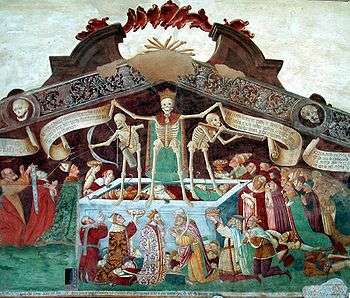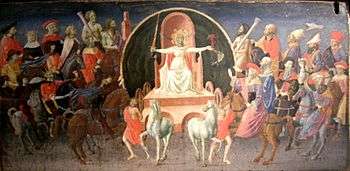Triumphs
 1450 illuminated manuscript of Trionfi illustrated by Ricciardo di Nanni | |
| Author | Francesco Petrarca (Petrarch) |
|---|---|
| Original title | Trionfi |
| Language | Tuscan |
| Genre | Poetry |
Publication date | 1351-1374 |
Original text | Trionfi at Italian Wikisource |
Triumphs (Italian: Trionfi) is a series of poems by Petrarch in the Tuscan language evoking the Roman ceremony of triumph, where victorious generals and their armies were led in procession by the captives and spoils they had taken in war. Composed over more than twenty years, the poetry is written in terza rima and divided into twelve chapters honoring allegorical figures such as Love, Chastity, Death, and Fame, who vanquish each other in turn. The last chapter was completed February 12, 1374, a few months before the author's death.
Structure
Triumphus Cupidinis: Triumph of Love
One spring day in Valchiusa, the poet falls asleep and dreams that Love, personified as a naked and winged young man armed with a bow, passes by on a fiery triumphal chariot drawn by four white horses. Love is attended by a multitude of his conquests, including illustrious historical, literary, mythological, and biblical figures, as well as ancient and medieval poets and troubadours. Eventually the procession reaches Cyprus, the island where Venus was born.
Triumphus Pudicitie: Triumph of Chastity
Love is defeated by Laura and a host of personified virtues such as Honor, Prudence and Modesty, as well as chaste heroines including Lucretia, Penelope, and Dido. Love's captives are freed and Love is bound to a column and chastised. The triumphant celebration culminates in Rome, in the Temple of Patrician Chastity.


Triumphus Mortis: Triumph of Death
Returning from the battle, the victorious host encounters a furious woman dressed in black, who reveals a countryside littered with the corpses of once proud people from all times and places, including emperors and popes. This personification of Death plucks a golden hair from Laura's head. Laura dies, but returns from heaven to comfort the poet, who asks when they will be reunited. She replies that he will live a long time without her.
Triumphus Famae: Triumph of Fame
Death departs and Fame arrives. Her appearance is compared to the dawn. She is attended by Scipio and Caesar, and many other figures from Rome's military history, as well as Hannibal, Alexander, Saladin, King Arthur, heroes from Homer's epics, and patriarchs from the Hebrew scriptures. Accompanying these soldiers and generals are the thinkers and orators of Classical Greece and Rome. It has been remarked that for Petrarch, Plato is a greater philosopher than Aristotle, who was preferred by Dante.
Triumphus Temporis: Triumph of Time
Time is represented by the sun, chasing the dawn and racing across the sky, jealous and scornful of the fame of mortals. Fame, the poet concludes, will always eventually be followed by oblivion, the "second death".
Triumphus Eternitatis: Triumph of Eternity
Petrarch finds consolation in the prospect of being reunited with Laura in timeless eternity. Eternity is not represented allegorically.
Analysis
Triumphs examines the ideal course of a man from sin to redemption: A theme with roots in medieval culture, being typical of works like Roman de la Rose or The Divine Comedy. Petrarch's work invites comparison with the Dante's, from the structural point of view (having adopted Dante's meter) as well as for its treatment of an allegorical voyage.
Triumphs shares and builds on numerous themes of Canzoniere, such as the confrontation of death, as in the sonnet Movesi il vecchierel canuto e bianco ("Grizzled and white the old man leaves"), and the spiritualization of love.
Criticism
Triumphs is appreciated for its lyrical achievements and the poet's vivid introspection into his feelings. On the other hand, it has been criticized for the mechanical rigidity of its narrative, and the long enumerations of notable persons which often sap its vitality.
References
- Boitani, Piero (1984). Chaucer and the Imaginary World of Fame. Boydell & Brewer Ltd. pp. 121–122. ISBN 0859911624.
